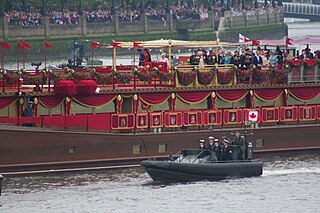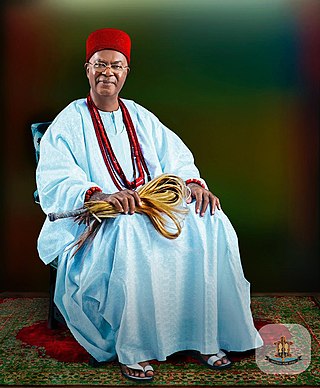
A social class is a grouping of people into a set of hierarchical social categories, the most common being the upper, middle and lower classes. Membership in a social class can for example be dependent on education, wealth, occupation, income, and belonging to a particular subculture or social network.
The means of production is a term which describes land, labor and capital that can be used to produce products ; however, the term can also refer to anything that is used to produce products. It can also be used as an abbreviation of the "means of production and distribution" which additionally includes the logistical distribution and delivery of products, generally through distributors, or as an abbreviation of the "means of production, distribution, and exchange" which further includes the exchange of distributed products, generally to consumers.
The bourgeoisie is a social class, equivalent to the middle or upper class. They are distinguished from, and traditionally contrasted with, the proletariat by their affluence, and their great cultural and financial capital. They are sometimes divided into a petty, middle, large, upper, and ancient bourgeoisie and collectively designated as "the bourgeoisie".

The middle class refers to a class of people in the middle of a social hierarchy, often defined by occupation, income, education, or social status. The term has historically been associated with modernity, capitalism and political debate. Common definitions for the middle class range from the middle fifth of individuals on a nation's income ladder, to everyone but the poorest and wealthiest 20%. Theories like "Paradox of Interest" use decile groups and wealth distribution data to determine the size and wealth share of the middle class.

In sociology, the ruling class of a society is the social class who set and decide the political and economic agenda of society. In Marxist philosophy, the ruling class are the capitalist social class who own the means of production and apply their cultural hegemony to determine and establish the dominant ideology of the society. In the 21st century, the worldwide political economy established by globalization has created a transnational capitalist class who are not native to any one country.

The three-component theory of stratification, more widely known as Weberian stratification or the three class system, was developed by German sociologist Max Weber with class, status and party as distinct ideal types. Weber developed a multidimensional approach to social stratification that reflects the interplay among wealth, prestige and power.

Petite bourgeoisie is a French term that refers to a social class composed of semi-autonomous peasants and small-scale merchants whose politico-economic ideological stance in times of socioeconomic stability is determined by reflecting that of a haute bourgeoisie with which the petite bourgeoisie seeks to identify itself and whose bourgeois morality it strives to imitate.
Class analysis is research in sociology, politics and economics from the point of view of the stratification of the society into dynamic classes. It implies that there is no universal or uniform social outlook, rather that there are fundamental conflicts that exist inherent to how society is currently organized.

Social stratification refers to a society's categorization of its people into groups based on socioeconomic factors like wealth, income, race, education, ethnicity, gender, occupation, social status, or derived power. As such, stratification is the relative social position of persons within a social group, category, geographic region, or social unit.

In political and sociological theory, the elite are a small group of powerful people who hold a disproportionate amount of wealth, privilege, political power, or skill in a group. Defined by the Cambridge Dictionary, the "elite" are "those people or organizations that are considered the best or most powerful compared to others of a similar type."
Social closure refers to the phenomenon by which groups maintain their resources by the exclusion of others from their group based on varied criteria. Closure is ubiquitous, being found in groups all over the world at all sizes and classes. Some examples of social closure include, “Access to private schools follows explicit rules and depends on financial capacities; access to university depends on a certificate or diploma, eventually from certain schools only; membership in a highly prestigious club depends on economic and social capital and the respective social networks; and finally, in the case of migration, people will have to be eligible for citizenship and pass the thorny path of naturalization.”

Social inequality occurs when resources in a given society are distributed unevenly, typically through norms of allocation, that engender specific patterns along lines of socially defined categories of persons. It posses and creates gender cap between individuals that limits the accessibility that women have within society. The differentiation preference of access of social goods in the society brought about by power, religion, kinship, prestige, race, ethnicity, gender, age, sexual orientation, and class. Social inequality usually implies the lack of equality of outcome, but may alternatively be conceptualized in terms of the lack of equality of access to opportunity. This accompanies the way that inequality is presented throughout social economies and the rights that are skilled within this basis. The social rights include labor market, the source of income, health care, and freedom of speech, education, political representation, and participation.
Marxian class theory asserts that an individual's position within a class hierarchy is determined by their role in the production process, and argues that political and ideological consciousness is determined by class position. A class is those who share common economic interests, are conscious of those interests, and engage in collective action which advances those interests. Within Marxian class theory, the structure of the production process forms the basis of class construction.
Dr. Frank Parkin was a British sociologist and novelist. He was a professor emeritus at the University of Kent and editor of the Concepts in the Social Sciences series published by Open University Press.
In Karl Marx's critique of political economy and subsequent Marxian analyses, the capitalist mode of production refers to the systems of organizing production and distribution within capitalist societies. Private money-making in various forms preceded the development of the capitalist mode of production as such. The capitalist mode of production proper, based on wage-labour and private ownership of the means of production and on industrial technology, began to grow rapidly in Western Europe from the Industrial Revolution, later extending to most of the world.

Marxism was introduced by Karl Marx. Most Marxist critics who were writing in what could chronologically be specified as the early period of Marxist literary criticism, subscribed to what has come to be called "vulgar Marxism." In this thinking of the structure of societies, literary texts are one register of the superstructure, which is determined by the economic base of any given society. Therefore, literary texts are a reflection of the economic base rather than "the social institutions from which they originate" for all social institutions, or more precisely human–social relationships, are in the final analysis determined by the economic base.

In Marxist philosophy, the dictatorship of the proletariat is a condition in which the proletariat holds state power. The dictatorship of the proletariat is the intermediate stage between a capitalist economy and a communist economy, whereby the post-revolutionary state seizes the means of production, compels the implementation of direct elections on behalf of and within the confines of the ruling proletarian state party, and instituting elected delegates into representative workers' councils that nationalise ownership of the means of production from private to collective ownership. During this phase, the administrative organizational structure of the party is to be largely determined by the need for it to govern firmly and wield state power to prevent counterrevolution and to facilitate the transition to a lasting communist society. Other terms commonly used to describe the dictatorship of the proletariat include socialist state, proletarian state, democratic proletarian state, revolutionary dictatorship of the proletariat and democratic dictatorship of the proletariat. In Marxist philosophy, the term dictatorship of the bourgeoisie is the antonym to the dictatorship of the proletariat.
The proletariat is the social class of wage-earners, those members of a society whose only possession of significant economic value is their labour power. A member of such a class is a proletarian. Marxist philosophy considers the proletariat to be exploited under capitalism, forced to accept meager wages in return for operating the means of production, which belong to the class of business owners, the bourgeoisie.

Permanent revolution is the strategy of a revolutionary class pursuing its own interests independently and without compromise or alliance with opposing sections of society. As a term within Marxist theory, it was first coined by Karl Marx and Friedrich Engels as early as 1850, but since then it has been used to refer to different concepts by different theorists, most notably Leon Trotsky.

The social structure in Nigeria is the hierarchical characterization of social status, historically stratified under the Nigerian traditional rulers and their subordinate chiefs, with a focus on tribe and ethnicity which continued with the advent of colonization.







